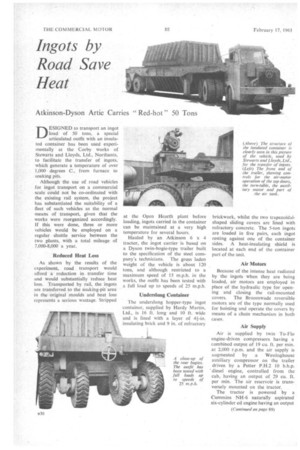Ingots by Road Save Heat
Page 64

Page 67

If you've noticed an error in this article please click here to report it so we can fix it.
Atkinson-Dyson Artie Carries " Red-hot " 50 Tons
DESIGNED to transport an ingot load of 50 tons, a special articulated outfit with an insulated container has been used experimentally at the Corby works of Stewarts and Lloyds, Ltd., Northants, to facilitate the transfer of ingots, which generate a temperature of over 1,000 degrees C., from furnace to soaking pits.
Although the use of road vehicles for ingot transport on a commercial scale could not be co-ordinated with the existing rail system, the project has substantiated the suitability of a fleet of such vehicles as the normal means of transport, given that the works were reorganized accordingly. If this were done, three or more vehicles would be employed on a regular shuttle service between the two plants, with a total mileage of 7,000-8,000 a year.
Reduced Heat Loss
As shown by the results of the experiment, road transport would afford a reduction in transfer time and would substantially reduce heat loss. Transported by rail, the ingots are transferred to the soaking-pit area in the original moulds and heat loss represents a serious wastage. Stripped at the Open Hearth plant before loading, ingots carried in the container can be maintained at a very high temperature for several hours.
Hauled by an Atkinson 6 x 4 tractor, the ingot carrier is based on a Dyson twin-bogie-type trailer built to the specification of the steel company's technicians. The gretss laden weight of the vehicle is about 120 tons, and although restricted to a maximum speed of 15 m.p.h. in the works, the outfit has been tested with a full load up to speeds of 25 m.p.h.
Underslung Container
The underslung hopper-type ingot container, supplied by Hardy Martin, Ltd., is 16 ft. long and 10 ft. wide and is lined with a layer of 4f-in, insulating brick and 9 in. of refractory brickwork, whilst the two trapezoidalshaped sliding covers are lined with refractory concrete. The 5-ton ingots are loaded in five pairs, each ingot resting against one of the container sides. A heat-insulating shield is located at each end of the container part of the unit.
Air Motors
Because of the intense heat radiated by the ingots when they are being loaded, air motors are employed in place of the hydraulic type for opening and closing the rail-mounted covers. The Broomwade reversible motors are of the type normally used for hoisting and operate the covers by means of a chain mechanism in both cases.
Air Supply Air is supplied by twin Tu-Flo engine-driven compressors having a combined output of 19 cu. ft. per min. at 2,000 r.p.m. and the air supply is augmented by a Westinghouse auxiliary compressor on the trailer driven by a Petter P.H.2 10 b.h.p. ' diesel engine, controlled from the cab, having an output of 29 Cu. ft. per min. The air reservoir is transversely mounted on the tractor.
The tractor is powered by a Cummins NH-6 naturally aspirated six-cylinder oil engine having an output (Continued on page 89)
of 212 b.h.p. at 2,100 r.p.m. and a maximum torque rating of 580 lb.-ft. Torque is transmitted through a fluid flywheel coupled by a Layrub-jointed jack shaft to a Self-Changing Gears RV.38 five-speed air-operated gearbox, and thence to a Kirkstall Forge doubledrive bogie with double-reduction axles, each of the axles being equipped with two epicyclic reduction gears outrigged from the differential. Gearbox ratios comprise a first gear of 6.32 to 1, a second gear of 4.28 to 1, a third gear of 2.426 to 1, a fourth gear of 1.59 to 1 and a top gear of 1 to I. Final drive ratio is 6 to 1.
Steering Servo A Clayton Dewandre air-pressureoperated steering servo is fitted, and this feature combined with easy gear changing is a valuable aid to manceuvrability and exact location of the vehicle in confined spaces. Both tractor and trailer are fitted with an air-pressure braking system of the same make, Tractor and trailer bogies are equipped with Dunlop 14.00--24 (22ply) covers, whilst the front wheels of the tractor carry Dunlop 12.00-20 (14-ply) tyres. Conventional leaf springs are employed for the tractor front axle, and the bogie suspension is of the trunnion-mounted leaf-spring type.
Each trailer bogie comprises a swinging beam with trunnion ends on which are mounted in-line-type wheel carriers. This arrangement provides a notably " good ride " for the ingots over rough and uneven ground—animportant' consideration on this type of work.
Overall Length 54 ft.
Main dimensions of the outfit include a tractor length of 22 ft. and a trailer length of 41 ft., the combined length being 54 ft. The overall width is 12 ft. 6 in. and the height of the main frame is 6 ft. 11 in. Longitudinal chassis members are of 11 in. X 3 in.
channel-section of gauge. Detail:, of equipment include a fifth-wheel type `tractor-trailer coupling and manually operated support jacks.
Capacity of the air reservoir is 29 CU, ft.
The vehicle is lubricated throughout with Mobiloil products, an S.A.E. 10W/30 multigrade oil, Delvae Special, being used for the engine and gearbox, a multi-purpose S.A.E. 90 gear oil. G-X90, for the rear axles and a multi-purpose grease, Mobilgrease MP, for the chassis. This standardization of lubricant is in accord with Stewarts and Lloyds' general policy relating to road vehicles. Under the supervision of the Mobiloil company, a single grade of engine, oil is employed for all cars and commercial vehicles operated by the concern, whilst one grade of axle oil and one grade of grease are universally applied to every vehicle that is operated in their fleet.




















































































































